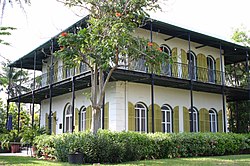
Back منزل إرنست همينغوي Arabic আর্নেস্ট হেমিংওয়ের বাড়ি Bengali/Bangla Hemingway-Haus German خانه ارنست همینگوی Persian Maison d'Ernest Hemingway French בית ארנסט המינגוויי HE 어니스트 헤밍웨이 박물관 Korean Ernest Hemingway House Dutch Casa Ernest Hemingway Romanian Ernest Xeminguey uyi Uzbek
Ernest Hemingway House | |
 Hemingway House in Key West, Florida | |
 Interactive map showing the Hemingway House's location | |
| Location | 907 Whitehead Street Key West, Florida |
|---|---|
| Coordinates | 24°33′04″N 81°48′02″W / 24.55119°N 81.80060°W |
| Built | 1851[1] |
| NRHP reference No. | 68000023 |
| Significant dates | |
| Added to NRHP | November 24, 1968[3] |
| Designated NHL | November 24, 1968[2] |
The Ernest Hemingway House was the residence of American writer Ernest Hemingway in the 1930s. The house is situated on the island of Key West, Florida. It is at 907 Whitehead Street, across from the Key West Lighthouse, close to the southern coast of the island. Due to its association with Hemingway, the property is the most popular tourist attraction in Key West. It is also famous for its large population of so-called Hemingway cats, many of which are polydactyl.
The residence was constructed in 1851 in a French Colonial style by wealthy marine architect and salvager Asa Tift. From 1931 to 1939, the house was inhabited by Hemingway and his wife Pauline Pfeiffer. They restored the decaying property and made several additions. During his time at the home, Hemingway wrote some of his best-received works, including the non-fiction work Green Hills of Africa (1935), the 1936 short stories "The Snows of Kilimanjaro" and "The Short Happy Life of Francis Macomber", and the novels To Have and Have Not (1937) and Islands in the Stream (1970).[note 1] After the Hemingway's divorce and deaths, the house was auctioned off and subsequently converted into a private museum in 1964. On November 24, 1968, it was designated a National Historic Landmark.[2]
- ^ "The House". The Ernest Hemingway Home and Museum. Archived from the original on February 15, 2011. Retrieved February 12, 2007.
- ^ a b "Hemingway, Ernest, House". National Historic Landmarks Program. Archived from the original on June 4, 2008. Retrieved September 18, 2008.
- ^ "National Register of Historical Places – Florida (FL), Monroe County". National Register of Historic Places. National Park Service. February 12, 2007.
- ^ Ricks, Christopher (October 8, 1970). "At Sea with Ernest Hemingway". The New York Times. Retrieved October 4, 2020.
Cite error: There are <ref group=note> tags on this page, but the references will not show without a {{reflist|group=note}} template (see the help page).

